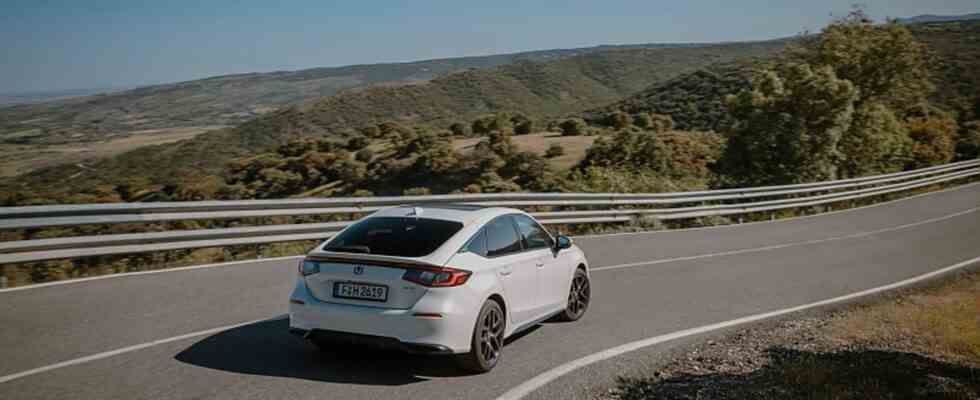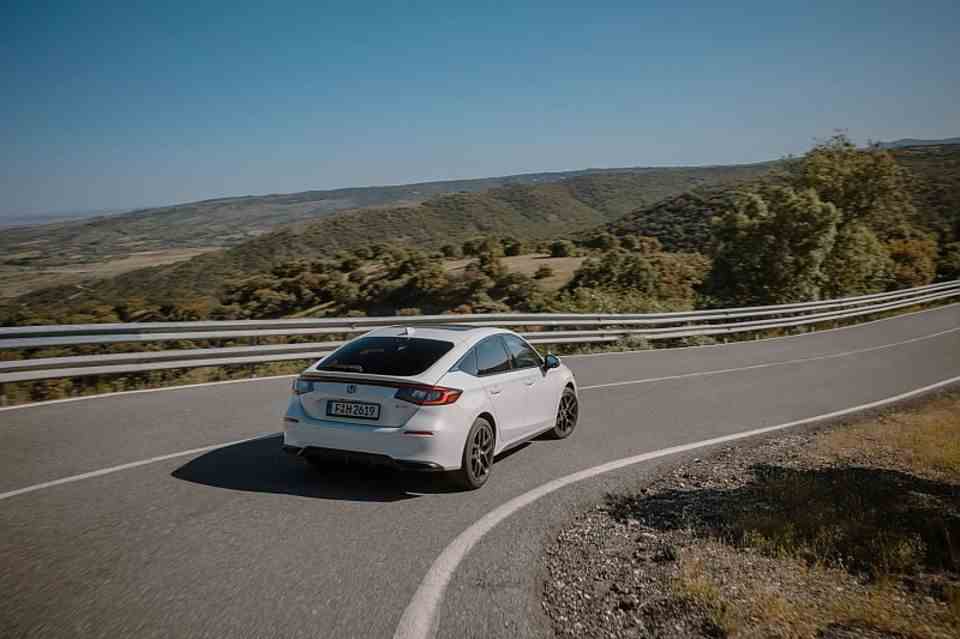Driving report FB Honda Honda Civic e:HEV
Eurofighter
Honda Civic e:HEV
© press-inform – the press office
The eleventh generation of the Honda Civic was first designed in Europe for the whole world. This measure is paying off. However, Honda only offers the compact car in Germany as a hatchback sedan.
Honda is something like the Gallic village of Japanese car manufacturers. Regardless of powerful neighbor Toyota, they’re doing their own thing in Tokyo. Be it hydrogen or electromobility. Whether electricity or not. The Honda development maxim applies to every model: “Man maximum, machine minimum”. Which means nothing else, that the vehicle is constructed around the human being. From the powertrain to the interior.
In the eleventh generation of the Honda Civic, which is only available in euros as a hatchback, it should offer the driver and passengers more space and comfort than before. The new Nippon Golf is 4.55 meters long and has a wheelbase that is 35 millimeters longer than before. “The wheelbase completely benefits the rear passengers,” explains Honda technician Kotaro Yamamoto. The rear is actually much more spacious than before. There is enough space on the two front chairs anyway, as you sit sportily deep. The interior designers have put a lot of effort into the cockpit. The dashboard features a honeycomb structure that hides the air conditioning vents. The air flow is regulated with the help of pleasantly clicking levers. The trunk can’t quite keep up when it comes to the opulence of space and, with a volume of 410 liters, has a volume of 68 liters less than before. If the backrests of the rear seats are folded down, the volume increases to 1,220 liters. With the top model Advance (costs 36,600 euros), the storage space shrinks even more from 404 liters to 1,187 liters.
In return, the driver can only enjoy a virtual cockpit in this version, in which the digital instruments are displayed on a 10.2-inch monitor. The supplementary touchscreen, which is used to control the infotainment of the Honda Civic e:HEV, is nine inches. The home cinema is solid, nothing more. That’s why it’s all the better that an inductive charging cradle supplies the smartphone with power and Apple CarPlay and Android Auto are integrated wirelessly. Honda wouldn’t be Honda if you didn’t also think of the traditionalists. Two USB-A ports on the front and two on the back are available for charging smart devices.
The powertrain is the same as that of the Honda CR-V e:HEV, but has been further improved for the compact car. In the Honda Civic, the combination of combustion engine and electric motor delivers 135 kW / 184 hp and has a maximum torque of 315 Newton meters. The Japanese are also turning the interaction between petrol engines upside down in the compact car and assigning the drive task to the electric motor. According to the Honda technicians, this has advantages in terms of efficiency. Nevertheless, the engineers have further optimized the new two-liter four-cylinder. The petrol engine operates in the Atkinson cycle, in which the fuel is injected into the combustion chambers several times at high pressure. As a result, the thermal efficiency of the combustion engine is an impressive 41 percent. The battery still consists of 72 cells, but they have a higher energy density than before. Since the capacity remains at 1.5 kilowatt hours, the weight is reduced by one kilogram and the height by 23 millimeters. According to Honda, around two kilometers are possible purely electrically.
With a full hybrid like the Honda Civic e:HEV, however, it is not about the all-electric hunt for range records, but about the lowest possible fuel consumption. To achieve this, the engineers scrutinize every detail. A new power control unit (PCU) with more computing power controls the electrical supply of the hybrid system, while the higher energy density of the power unit (IPU) allows the electric motor to be used more often. This allows the internal combustion engine to run at a lower speed, which should reduce fuel consumption. Honda specifies 5.0 liters per 100 kilometers (WLTP). During our first test drive, which was sometimes carried out faster, we came up with a value of 6.5 l/100 km according to the on-board computer.
In action, the Civic e:HEV did pretty well. The chassis in particular made a good impression, cushioning the bumps in the road in a relaxed manner without teetering or putting the back muscles and intervertebral discs of the passengers to the test. The same applies to the drive train, at least as long as you take it easy with the accelerator pedal. Then the Honda is also pretty fast on the road. If the system detects cornering, the combustion engine speed is maintained when the accelerator is released in order to optimize acceleration out.
As soon as it needs to be suddenly accelerated, the combustion engine makes a very audible statement and the E-CVT transmission acts more like a rubber band. Although the automatic has nothing in common with a conventional continuously variable transmission except for the name. Because with the Honda Civic e:HEV, the torque is continuously changed by varying the current strength that is applied from the generator to the electric motor. It takes 7.9 seconds to reach country road speed (Advance 8.1). However, the top speed is only 180 km/h. The driving programs Eco, Normal, Sport differ noticeably in the throttle response and the return forces of the steering. Especially when it comes to sport, the Civic vibrates with an acoustic club and underscores the acceleration with an artificially generated engine sound. However, it cannot be deactivated in sport mode. This is only possible in the individual driving program.
So that the driver always has everything in view, the Asian technicians have lowered the bonnet by 25 millimeters and moved the A-pillar back by 50 millimeters. This increases the driver’s field of vision. When it comes to assistants, the Honda Civic e:HEV is well positioned. The compact car is the first Honda to receive an adaptive LED light, which is standard with the Advance equipment for 36,600 euros. There are also a number of other helpers: These include an active traffic jam assistant (up to 65 km/h), a blind spot warning system and a new 100-degree wide-angle camera that identifies pedestrians, lane markings and even motorcycles. The Civic e:HEV will be available from dealers from November and will cost at least 31,900 euros. The basic configuration already offers dual automatic air conditioning, a panoramic glass sunroof and tilting sunroof and the nine-inch touchscreen. A Ford Focus with titanium equipment as an MHEV with 92 kW / 125 hp with a seven-speed automatic transmission costs at least 31,050 euros according to the configurator.


